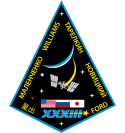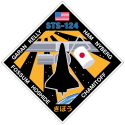Akihiko Hoshide
| Akihiko Hoshide | |
|---|---|
 | |
| Land | Japan |
| Organisation | JAXA |
| ausgewählt | 10. Februar 1999 (4. NASDA-Gruppe) |
| Einsätze | 3 Raumflüge |
| Start des ersten Raumflugs | 31. Mai 2008 |
| Landung des letzten Raumflugs | 9. November 2021 |
| Zeit im Weltraum | 340d 11h 41min |
| EVA-Einsätze | 4 |
| EVA-Gesamtdauer | 28h 17min |
| Raumflüge | |
| |
Akihiko Hoshide (jap.星出 彰彦, Hoshide Akihiko; * 28. Dezember 1968 in Setagaya-ku, Tokio, Präfektur Tokio, Japan) ist ein japanischer Astronaut.
Werdegang
Akihiko Hoshide erhielt 1992 einen Bachelor in Maschinenbau von der Keiō-Universität und einen Master of Science in Luft- und Raumfahrt 1997 von der University of Houston. Er ist bei der japanischen Weltraumagentur JAXA als Astronaut angestellt.
Hoshide trat 1992 der NASDA bei, arbeitete dort für zwei Jahre im Büro Nagoya und war an der Entwicklung der H-II-Trägerrakete beteiligt. 1994 bis 1999 arbeitete er im Astronautenbüro als Ingenieur für das Astronautentrainingsprogramm. Parallel dazu unterstützte er Kōichi Wakata bei seinem Training für STS-72.
Im Februar des Jahres 1999 wurde Hoshide als einer von drei japanischen Astronauten für die Internationale Raumstation ausgewählt. Daraufhin begann er im April 1999 mit dem Basistraining für Astronauten, welches er im Januar 2001 abschloss. Seit April 2001 hat er am erweiterten ISS-Training teilgenommen und unterstützte die Entwicklung von Teilen für das Labor Kibō und der Trägerrakete H-IIA (HTV).
Als am 1. Oktober 2003 die NASDA mit dem Institute of Space and Astronautical Science und dem National Aerospace Laboratory fusionierten, ging Hoshide mit in den Kader der neuen Japan Aerospace Exploration Agency (JAXA) über.
Ein Training als Flugingenieur für die Sojus-Kapsel schloss er im Mai 2004 am Juri-Gagarin-Kosmonautentrainingszentrum im Sternenstädtchen in Russland ab.
Astronautentätigkeit
Hoshide kam im Mai 2004 zum Johnson Space Center, wo er im Februar 2006 das Anwärtertraining für das amerikanische Space Shuttle und die ISS absolvierte. Zu diesem Training gehören neben wissenschaftlichen und technischen Einweisungen auch Überlebenstrainings zu Wasser und Land sowie Flugtraining auf der Northrop T-38.
STS-124
Am 31. Mai 2008 startete Hoshide mit der Raumfähre Discovery als Missionsspezialist zum ersten Mal ins All. STS-124 war ein Flug, der dem ISS-Ausbau diente. Primärziel der Mission war die Montage des japanischen Forschungslabors Kibō. Hoshide nahm das Modul als Vertreter der japanischen Raumfahrtbehörde in Betrieb. STS-124 war der zweite von insgesamt drei Flügen zur Installation von Kibō.
Erster Langzeitaufenthalt an Bord der ISS
Am 18. November 2009 gab die JAXA bekannt, dass Hoshide Mitglied der ISS-Expeditionen 32 und 33 ist. Er startete am 15. Juli 2012 mit dem Raumschiff Sojus TMA-05M zur ISS und arbeitet dort sechs Monate als Bordingenieur. Die Landung erfolgte am 19. November 2012.[1]
Zweiter Langzeitaufenthalt an Bord der ISS
Hoshide war für einen weiteren Langzeitaufenthalt an Bord der ISS vorgesehen. Der Start sollte nach Planung von 2018 etwa im Mai 2020 stattfinden. Vorgesehen war, dass Hoshide zunächst als Bordingenieur der ISS-Expedition 64 arbeitet und dann das Kommando der Expedition 65 übernimmt. Die Rückkehr zur Erde war für November 2020 geplant.[2]
Ende Juli 2020 wurde er für die Mission SpaceX Crew-2 eingeteilt,[3] die am 23. April 2021 startete. Er nahm dabei zunächst als Kommandant der Expedition 65 und dann als Bordingenieur an der Expedition 66 teil. Die Rückkehr zur Erde erfolgte am 9. November 2021.[4]
Siehe auch
Weblinks
- JAXA: Biografie (englisch)
- spacefacts.de: Kurzbiografie
Einzelnachweise
- ↑ Sojus-Kapsel bringt Astronauten sicher zur Erde. Die Welt, 19. November 2012, abgerufen am 19. November 2012.
- ↑ JAXA Astronaut Akihiko Hoshide Selected as ISS Expedition crew member and assuming the post of Commander. JAXA, 2. März 2018, abgerufen am 23. März 2018 (englisch).
- ↑ NASA: NASA Announces Astronauts to Fly on SpaceX Crew-2 Mission to Space Station. In: NASA Release 20-076. 28. Juli 2020, abgerufen am 12. August 2020 (englisch).
- ↑ Haygen Warren: Crew-2 returns to Earth after six-month stay on the ISS. nasaspaceflight.com, 8. November 2021, abgerufen am 9. November 2021 (englisch).
| Personendaten | |
|---|---|
| NAME | Hoshide, Akihiko |
| ALTERNATIVNAMEN | 星出 彰彦 (japanisch) |
| KURZBESCHREIBUNG | japanischer Astronaut |
| GEBURTSDATUM | 28. Dezember 1968 |
| GEBURTSORT | Setagaya-ku, Tokio, Präfektur Tokio, Japan |
Auf dieser Seite verwendete Medien
The official mission insignia for International Space Station (ISS) Expedition 66, designed to resemble US highway route 66
- The Expedition 66 patch celebrates the continued utilization of the International Space Station as a path for human and scientific space exploration.
- Its shape reflects the Route 66 highway sign, which once guided an earlier expansion into distant, remote lands. The arc of the Earth’s atmosphere is reminiscent of the well-known stop-motion photos taken by astronauts and cosmonauts of the Earth in eclipse.
- Two future destinations are depicted, the Moon resting inside one of the numerals, and Mars to the right. A multicolored bridge containing the colors of each of this mission’s international partner’s flags (Russia, Germany, France, Japan, and the United States) draws the viewer from the perimeter of the patch into the numeral 66 just as the space station bridges the gap from low-Earth orbit to these distant exploration destinations.
Das Expedition-33-Emblem stellt die Internationale Raumstation (ISS) dar, wie sie die Erde in Richtung Zukunft umkreist. Die Nationalflaggen Japans, Russlands und der Vereinigten Staaten von Amerika repräsentieren die Crew der Expedition 33, welche aus sechs Astronauten und Kosmonauten aus Japan, Russland und den Vereinigten Staaten besteht. Die fünf weißen Sterne repräsentieren die Partner im ISS-Programm – Kanada, die europäischen Länder, Japan, Russland und die Vereinigten Staaten. Die Expedition 33 wird die Arbeit der vorhergehenden 32 Expeditionsmannschaften an Bord des multinationalen Laboratoriums fortsetzen z. B. in Bereichen der Biologie und Biotechnologie, der Geowissenschaften und der Weltraumforschung, der Bildung, der menschlichen Forschung, der Natur- und Materialwissenschaften und der Technologieentwicklung und -vorführung.
International Space Station (ISS) Expedition 65 mission insignia
- The International Space Station Expedition 65 patch depicts the space station as it appears during the time the crew will be onboard. The space station flying over the Earth represents the overall reason for having a space station; to benefit the world through scientific research and international cooperation in space. When this expedition begins, the space station will have provided continued human presence in space for more than twenty years. Blue, the background color of the patch, symbolizes reliability.
- The stars represent the crew onboard the space station, as well as mission control centers located on three continents. Those stars, in that field of blue, also symbolize the thousands of space workers throughout the space station partnership who continue to contribute to the success of our International Space Station.
The SpaceX Crew-2 official insignia
- The determined expression of the Dragon reflects the strength of the team and their contribution to the exploration of space. The five large stars represent the five partner space agencies coopering the International Space Station program. Designed by Gregory Manchess
Emblem of Nasa's STS-124 mission.
- The STS-124/1J patch depicts the Space Shuttle Discovery docked with the International Space Station (ISS). STS-124/1J is dedicated to delivering and installing the Japanese Experiment Module (JEM) known as Kibo (Hope) to the ISS. The significance of the mission and the Japanese contribution to the ISS is recognized by the Japanese flag depicted on the JEM Pressurized Module (JPM) and the word Kibo written in Japanese at the bottom of the patch. The view of the sun shining down upon the Earth represents the increased "hope" that the entire world will benefit from the JEM's scientific discoveries. The JPM will be the largest habitable module on the ISS and is equipped with its own airlock and robotic arm for external experiments. In addition to delivering and installing the JPM, the STS-124 crew will relocate the JEM Logistics Pressurized (JLP) module to its permanent home on the zenith side of the JPM. During three planned space walks, the crew will perform external ISS maintenance and JPM outfitting, as well as extensive robotic operations by the ISS, space shuttle, and JEM robotic arms. It will be the first time that three different robotic arms will be operated during a single space flight mission.
Dieses Emblem repräsentiert die 32. Expedition zur Internationalen Raumstation (ISS) und die Bedeutung der Wissenschaft, die dort für gegenwärtige und zukünftige Generationen führend ist. Die Torbogengestalt des Emblems symbolisiert den „Eingang“ in zukünftige Weltraumforschungsmöglichkeiten. Die ISS, ein kreisendes Laboratorium über der Erde, bietet eine einzigartige Perspektive für Erdbeobachtung und -überwachung. Die Flamme beschreibt das Streben nach Wissen und unterstreicht die Bedeutung von Bildung als den Schlüssel zu zukünftiger menschlicher Raumfahrt. Das Astronautensymbol umkreist die Erde, die Arbeit aller Astronauten der Vergangenheit, der Gegenwart und der Zukunft würdigend. Die Namen von jedem Crewmitglied auf dem Rand des Emblems sind zu Ehren der verschiedenartigen Kulturen und Sprachen bei der Mission geschrieben. Die drei Flaggen stellen auch die Heimatländer der Expedition 32 Crewmitglieder dar und kennzeichnen die mitwirkende ISS-Partnerschaft von 15 Ländern als eins.
Japan Aerospace Exploration Agency (JAXA) astronaut Akihiko Hoshide, attired in a training version of his Extravehicular Mobility Unit (EMU) spacesuit.






